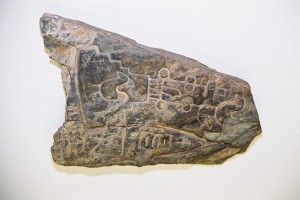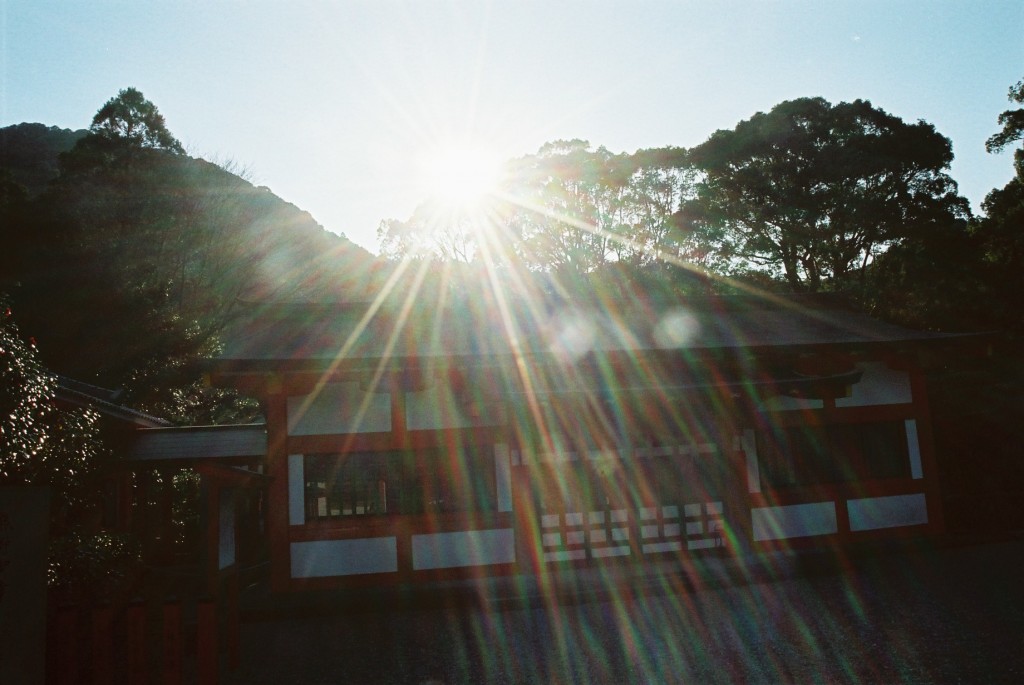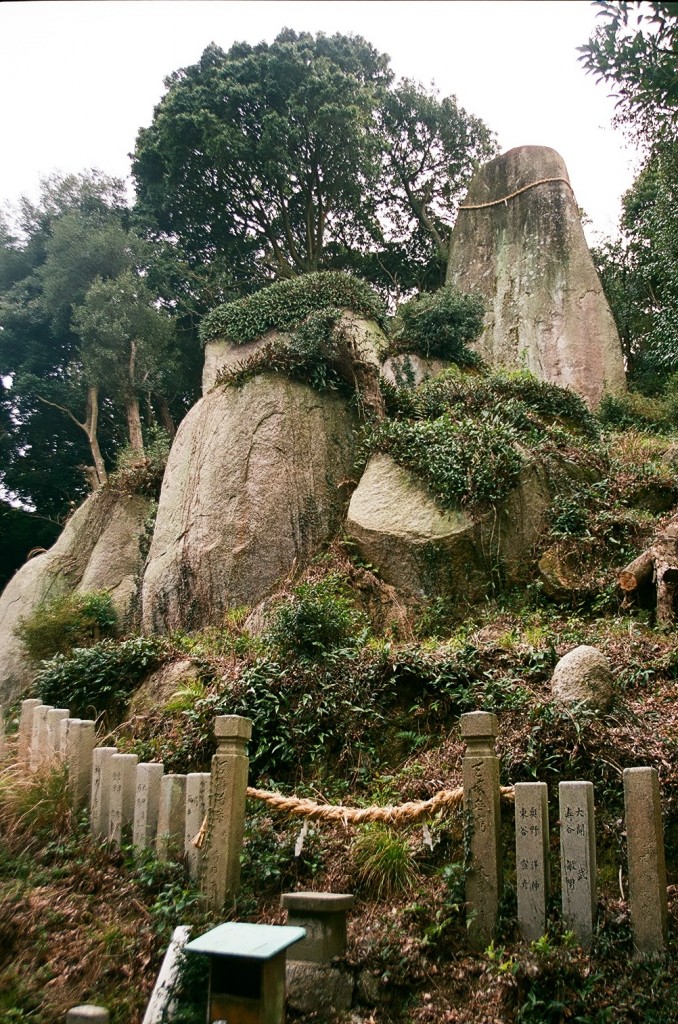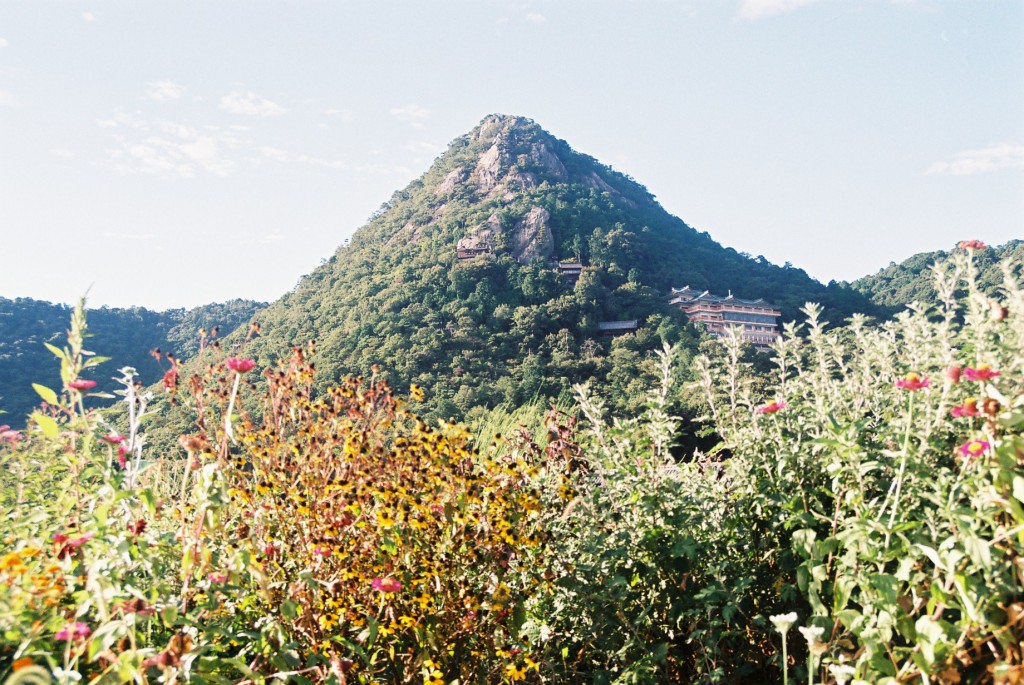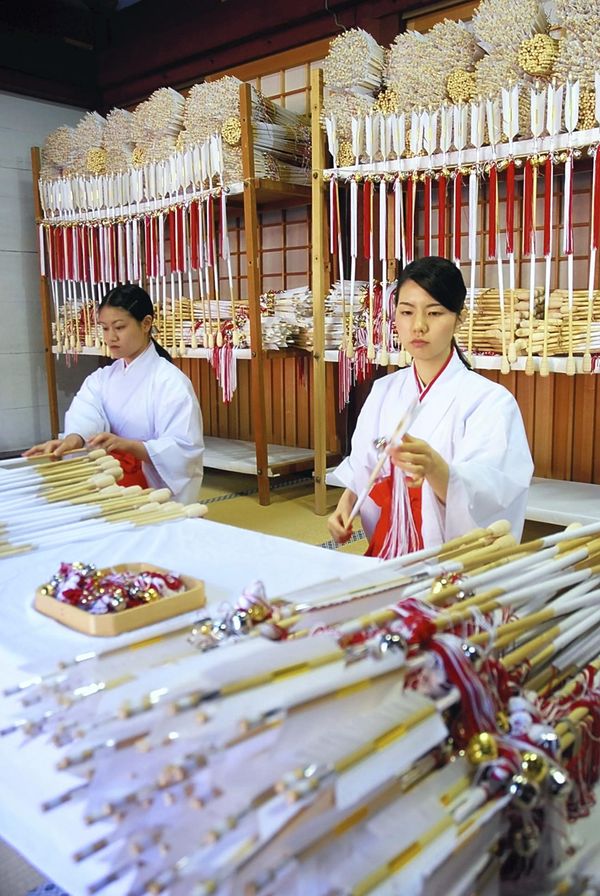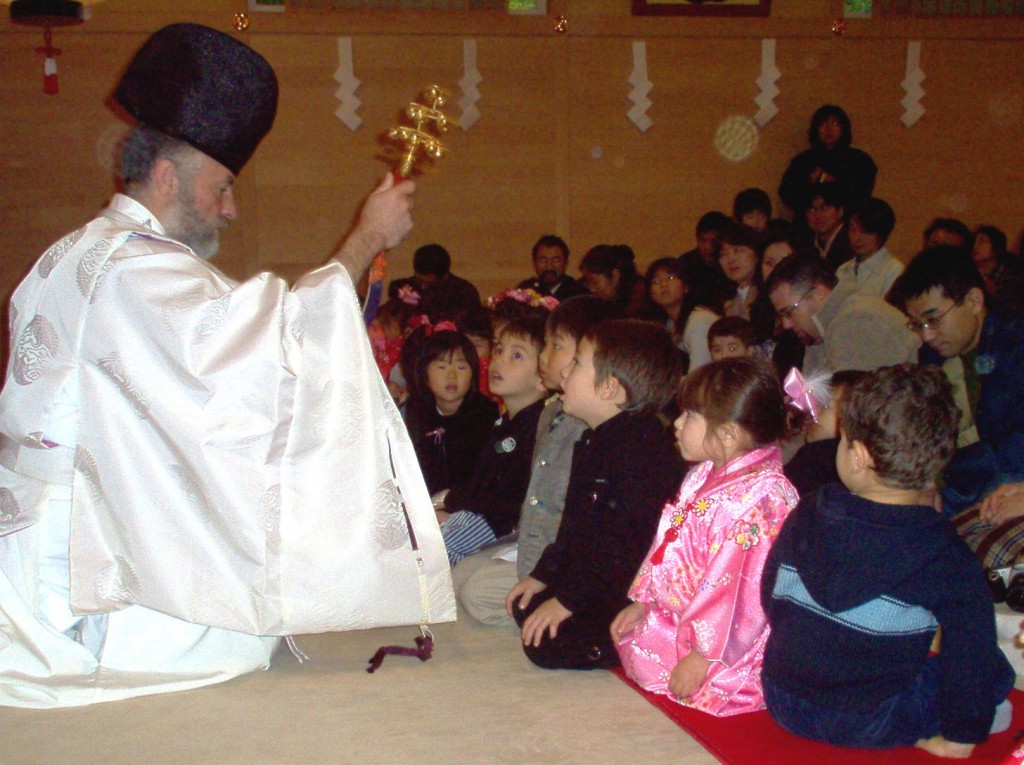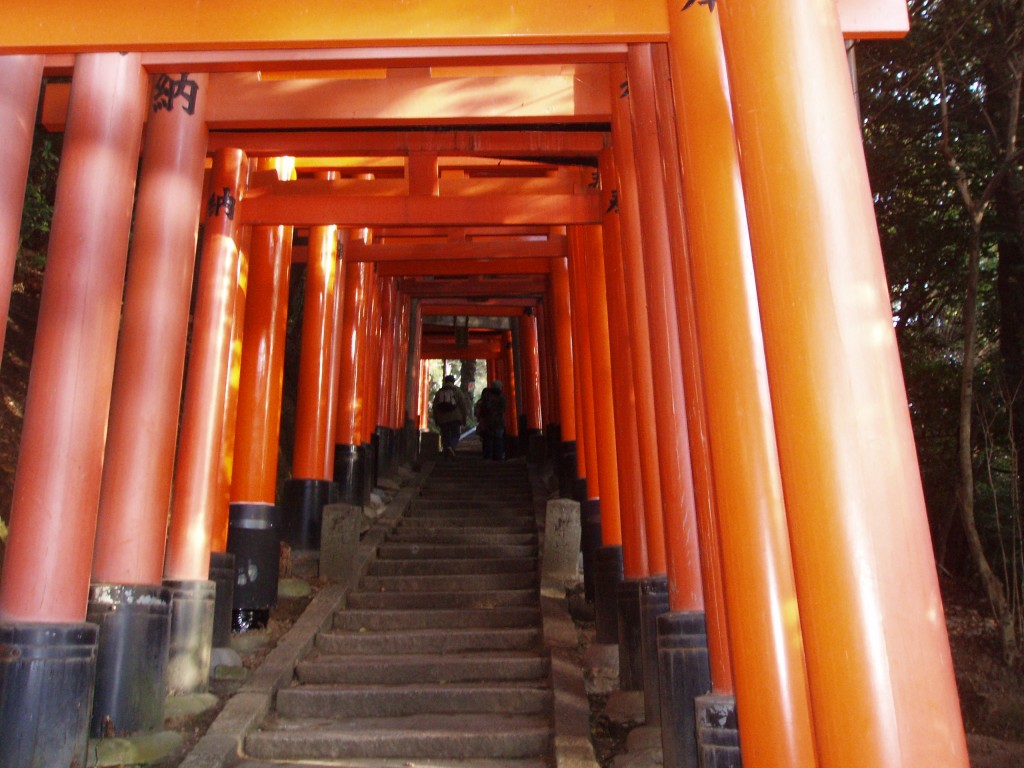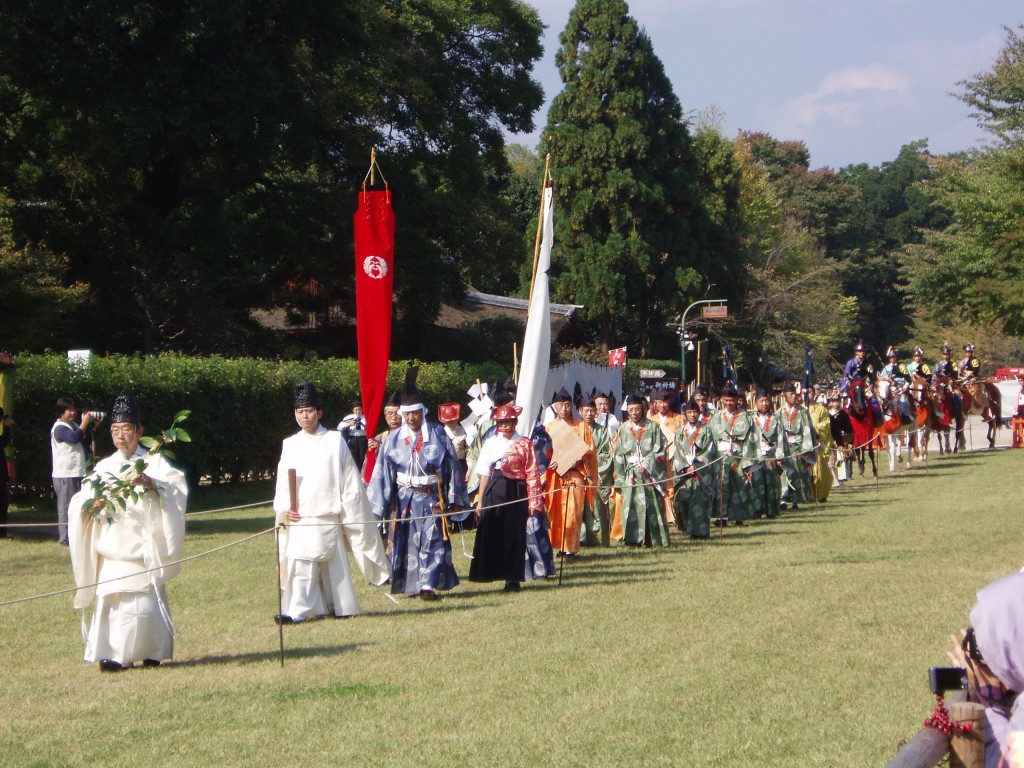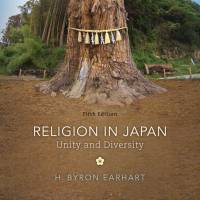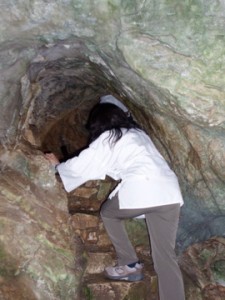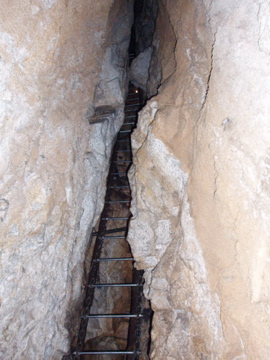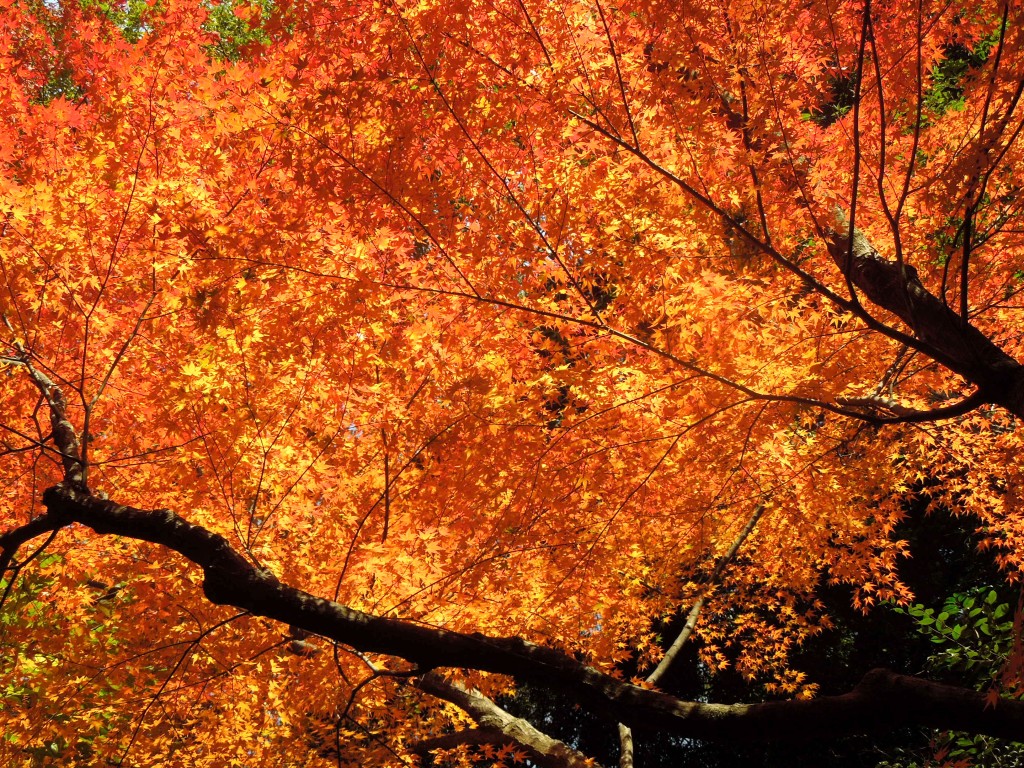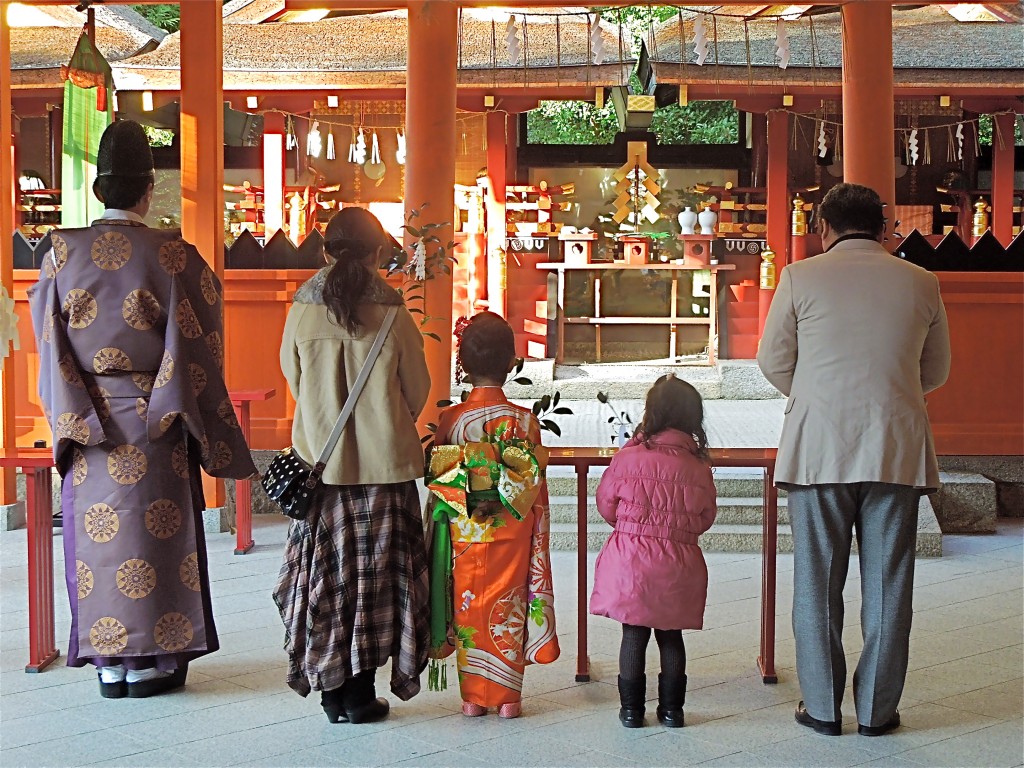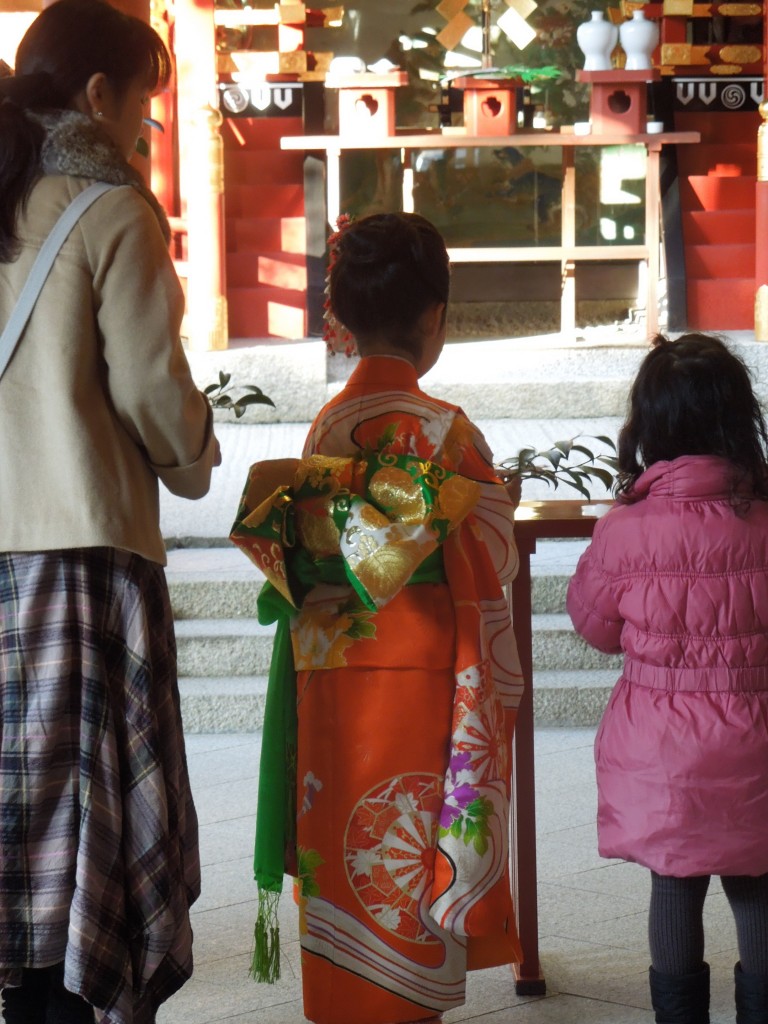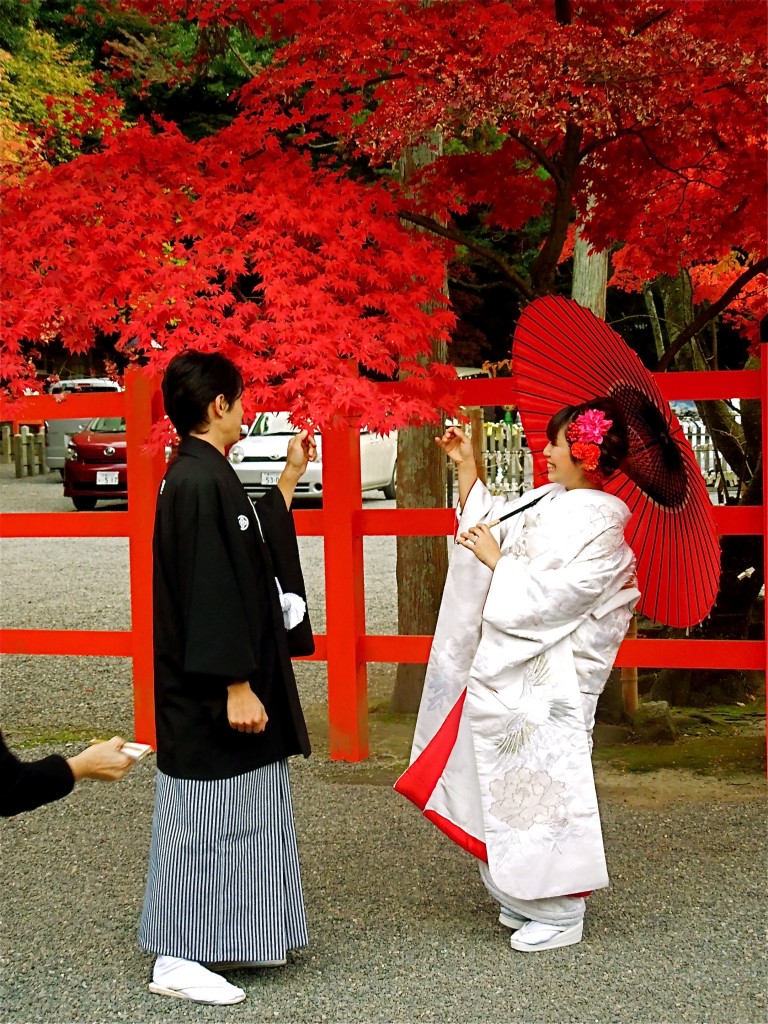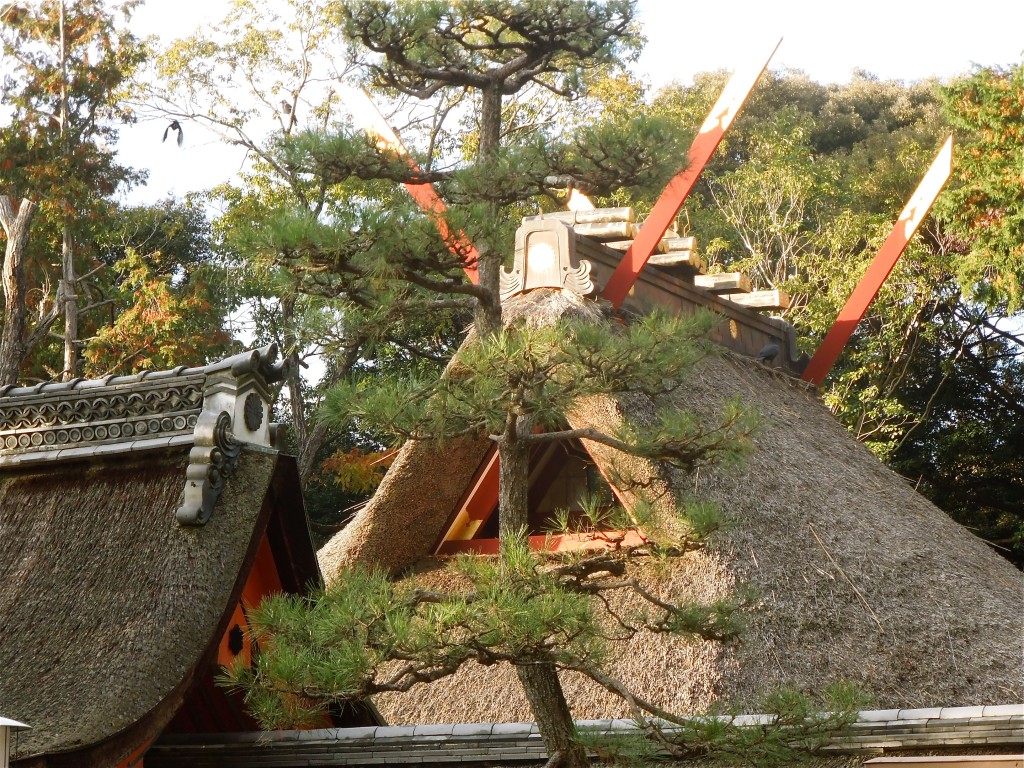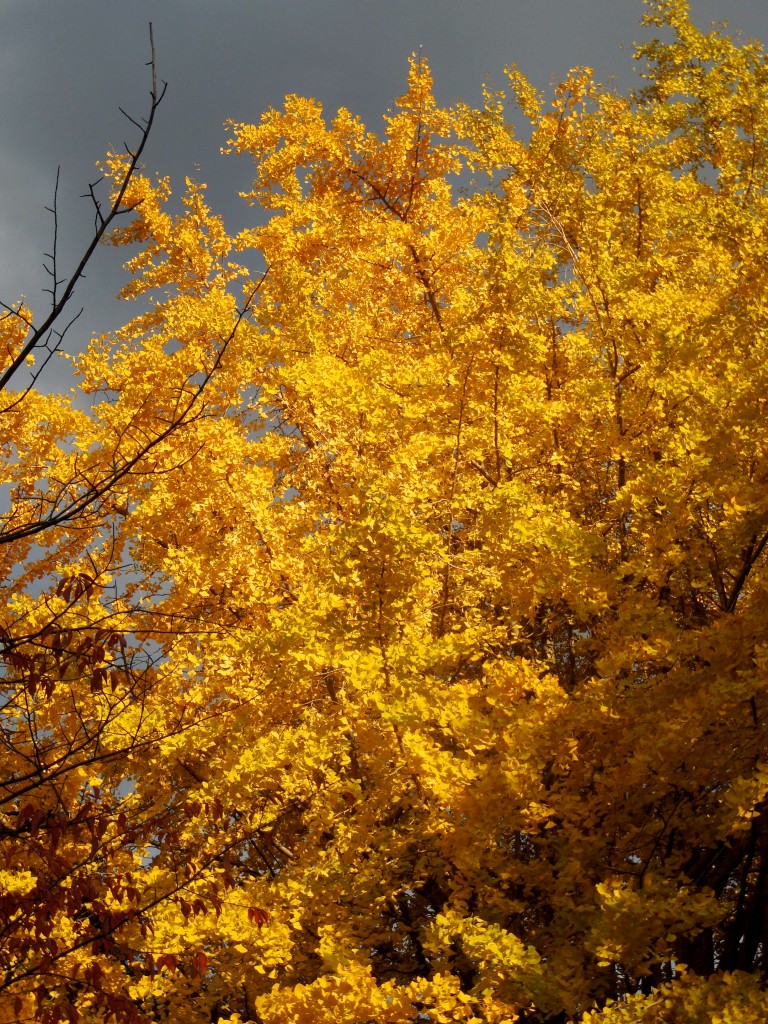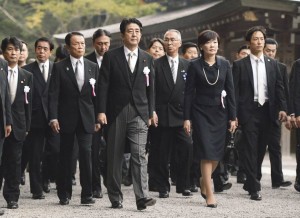
Prime Minister Shinzo Abe visits Ise Shrine on Oct. 5 to watch the Sengyo no Gi, an important Shinto ritual that is held to transfer the symbol of the shrine's deity between buildings. (Courtesy KYODO)
Back to the future: Shinto’s growing influence in politics
BY DAVID MCNEILL SPECIAL TO THE JAPAN TIMES NOV 23, 2013
A small organization, little known to the public, has helped restore much of Japan’s controversial past — and it is only getting started
Immaculate and ramrod straight in a crisp, black suit, Japan’s education minister, Hakubun Shimomura, speaks like a schoolteacher — slowly and deliberately. His brow creases with concern when he talks about Japan’s diminished place in the world, its years of anemic economic growth and poorly competing universities. Mostly, though, he appears to be worried about the moral and spiritual decline of the nation’s youth.
“The biggest problem with Japanese education is the tremendous self-deprecation of our high school children,” he says in an interview at his Tokyo office. He cites an international survey in which children are asked: “Are there times when you feel worthless?” Eighty-four percent of Japanese kids say yes — double the figure in the United States, South Korea and China, he laments. “Without changing that, Japan has no future.”
Shimomura’s remedy for this corrosive moral decay is far-reaching: Children will be taught moral and patriotic education and respect for Japan’s national symbols, its “unique” culture and history. Textbooks will remove “self-deprecating” views of history and references to “disputed” war crimes. They will reflect the government’s point of view on key national issues, such as Japan’s bitter territorial disputes with its three closest neighbors: China, Russia and South Korea.
Education reform represents only one layer of Shimomura and his government’s ambitions. Prime Minister Shinzo Abe, a close political ally, wants to revise three of the country’s basic modern charters: the 1946 Constitution, the education law, which they both think undervalues patriotism, and the nation’s security treaty with the United States. The Emperor would be returned to a more prominent place in Japanese society. The special status of Yasukuni Shrine, which enshrines most of Japan’s war dead, including the men who led the nation to disaster between 1933 and 1945, would be restored.

Mark R. Mullins, University of Auckland
“They’re trying to restore what was removed by the U.S. Occupation reforms,” explains Mark Mullins, director of the Japan Studies Center at the University of Auckland. If it succeeds, the project amounts to the overturning of much of the existing order in Japan — a return to the past, with one eye on the future.
Shinto Seiji Renmei (the Shinto Association of Political Leadership)
For an explanation of the core philosophy behind this project I visit an imposing black building that sits on the leafy borders of Meiji Shrine in Tokyo. The Association of Shinto Shrines, representing about 80,000 shrines, is classed as a religious administrative organization. It is also one of Japan’s most successful political lobbyists.
Many of the nation’s top elected officials, including Abe and Shimomura are members of the organization’s political wing, Shinto Seiji Renmei (officially, the Shinto Association of Spiritual Leadership — eschewing the word “political” from the title). A sister organization, the Shinto Political Alliance Diet Members’ Association boasts 240 lawmakers, including 16 out of the government’s 19-member Cabinet. Abe is the association’s secretary-general.
Seiji Renmei sees its mission as renewing the national emphasis on “Japanese spiritual values.” In principle, this means pushing for constitutional revision and patriotic and moral education, and staunchly defending conservative values in ways that seem to contradict Abe’s internationalist capitalism. The association opposes the free trade of rice and the sale of “strategic property” such as forests or lakes to non-Japanese, for instance.
Since its birth in 1969, Shinto Seiji Renmei has notched several victories in its quest to restore much of the nation’s prewar political and social architecture. In 1979, it successfully lobbied the government to reinstate the practice of using imperial era names. In 2007, it won a national holiday, April 29, for Japan’s wartime monarch, Hirohito — a day when Japanese might “look in awe at the sacred virtues of the Showa Emperor.”
The symbolic role of Yasukuni
Over the past decade, Tokyo has tried to impose a directive demanding that teachers lead schoolchildren in singing the Kimigayo national anthem — another Shinto concern. In April this year, 168 Diet members visited Yasukuni for its spring festival — the largest number since these counts began 24 years ago. “A lot more politicians now understand the importance of our views,” concludes Yutaka Yuzawa, head of Shinto Seiji Renmei.
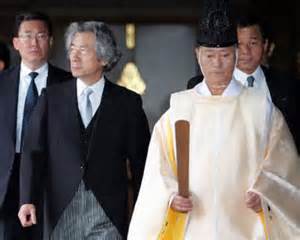
The then prime minister Koizumi Junichiro visiting Yasukuni
Though not a member of the association, former Prime Minister Junichiro Koizumi helped end the taboo on any overt show of sympathy with the militarism of the past with his six pilgrimages to Yasukuni, climaxing in his visit on Aug. 15, 2006. Yuzawa’s father, Tadashi, was the head priest of Yasukuni at the time. For both, it was a vindication of years of struggle. “Our stance is that it is natural for the prime minister to pay his respects at the shrine on behalf of the country.” Lawmakers such as former Prime Minister Naoto Kan who refuse to go are “impertinent,” he adds.
Yuzawa accepts that these visits will worsen already dangerously frayed ties with Beijing and Seoul but insists it is “not something Japan can bend on.” “It relates to our culture, history and tradition,” he says. “To us, Yasukuni Shrine is a god.” Criticism that prime-ministerial visits confer legitimacy on the Class-A war criminals enshrined there cannot be taken seriously, he says.
“Perhaps, according to today’s judgment, they might have made mistakes but back then they were doing their best for the country. In Japan, our way of thinking about the dead souls is that we don’t criticize them. They were protecting the Emperor and, by extension, the Japanese people.” That vital point, he says, is now understood by a growing number of Japanese politicians.
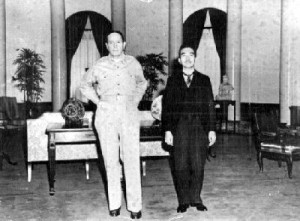
MacArthur and Hirohito at a meeting, not long before the emperor renounced his divinity
The American Occupation of 1945-51 ended Shinto’s status as a state religion and attempted to banish its influence from Japan’s public sphere, notably its emphasis on a pure racial identity linked to the Emperor. The core element of this belief, ruthlessly enforced through the education system, was the emperor’s divine status as a direct descendant of the sun goddess Amaterasu. Though weakened, Shinto conservatives in Japan “were simply biding their time” until they could restore the religion’s rightful place in Japanese society, says Mullins.
He sees 1995 — the year of the Kobe earthquake and Aum Shinrikyo deadly gas attacks on Japan’s subway — as a turning point. The two events, combined with the agonizing decline of the miracle economy, had a profound impact on the nation’s confidence. “The sense after that was: ‘We have so many troubles in Japan, we need to go back and get what we had,’ ” recalls Mullins. “There are certain people very sympathetic to that, to Shinto’s restoration vision.”
Prime minister Abe
One of those people is Abe. In October, he became the first prime minister in 84 years to attend the most important ceremony in Shinto, the Sengyo no Gi at Ise Shrine — a centuries-old ritual in which the main shrine buildings are demolished and rebuilt. Ise is considered home to the emperor’s ancestors; Amaterasu is enshrined in the inner sanctum. The highlight of the ceremony is the removal of a mythological “sacred mirror” used to lure the sun goddess out of her cave. Abe took eight members of his Cabinet along to watch. Some scholars were agnostic on the visit, given that prime ministers routinely go to the shrine to show respect for Japanese traditions and culture. Others, however, were alarmed.
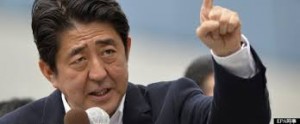
Japan's prime minister, Abe Shinzo (from Huffington Post)
“In the past, Ise Jingu (shrine) was the fountainhead for unifying politics and religion and national polity fundamentalism,” author Hisashi Yamanaka recently told the Asahi newspaper. “Abe’s act is clearly a return to the ways before World War II.”
It is far from clear how much of the past, exactly, Abe and his Cabinet want to revive, or how much sway Shinto holds over them. Shimomura swats away concerns about the government’s agenda. “Sections of the media have an allergy to moral education,” he says. “They are sending out the wrong image that we are trying to reinstate the prewar education system.” However, parts of Shinto clearly sit uneasily with the modern, globalized economy the government says it is trying to build.
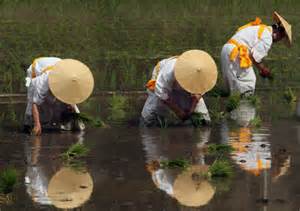
Rice planting ceremony - rice is a sensitive political issue in the current TPP talks (zimbio.com)
Yuzawa says Japan should prohibit sales of land and property to China, Japan’s largest trading partner. Another possible point of conflict is the free trade of agricultural products, a key demand of U.S. negotiators in the Trans-Pacific Partnership trade talks. Traditional ties between rice cultivation and Shinto rituals make this a no-no for Shinto fundamentalists, historian Matthew Penney notes in a recent article on the Asia-Pacific Journal.
Fundamentalism
Mullins says this magnetic tug of the past is not unique to Japan. “I see Shinto fundamentalists as very similar to U.S. Christian fundamentalists and Hindu neo-nationalists,” he says. “It’s people trying to cope with the modern world: to make it all black and white and nail it down.”

Shinto scholar John Breen, of Kyoto's International Research Center for Japanese Studies
But he says an “ecumenical group” of like-minded conservatives is in the ascendancy in Japan, led by Shinto and Nippon Kaigi, a nationalist think tank that advocates a return to “traditional values” and rejects Japan’s “apology diplomacy” for its wartime misdeeds. “Abe’s comeback has given them this sense of confidence,” Mullins says.
Whatever happens to his government’s larger agenda — much depends on Abe’s economic performance — Shinto conservatives will likely continue their quiet mission to transform Japan. John Breen, a religion specialist at the International Research Center for Japanese Studies in Kyoto, cites the restoration of imperial markers on the annual calendar: State Foundation Day; Culture Day, which marks the birthday of the Meiji Emperor; the current Emperor’s birthday in December; and Labor thanksgiving, which marks “the Emperor’s annual performance of the Niiname rite, a celebration of Amaterasu’s gift of rice to Japan.”
“The deep imperial meanings of these holidays are concealed behind innocuous names like Culture day and Labor thanksgiving,” Breen says. But the Shinto Association of Spiritual Leadership is determined to restore their original titles, “and so make apparent to all their true meaning.”

